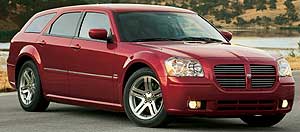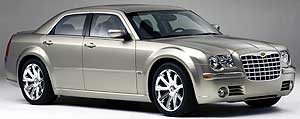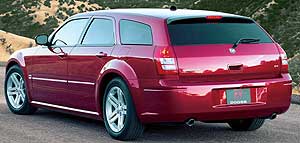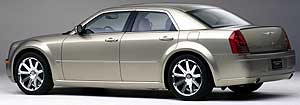2005 Dodge Magnum and 2005 Chrysler 300 Program #2334
The front-wheel drive family car has been the American standard for almost 25 years, but now that could be changing. Chrysler Group is launching a pair of large rear-wheel drive cars that give up nothing in traction or space to their front-drive competition: The 2005 Dodge Magnum and Chrysler 300. But is America ready to change drive wheels, and is the Chrysler duo powerful enough to do it?
That depends on where you look for power. If it’s in styling, technology, or engines, then the new 2005 Dodge Magnum Sports Tourer and Chrysler 300 sedan definitely deliver. These new big guns of the family car segment mix muscle car and family hauler into a pair of stout, rear-drive alternatives to front-drive 4-doors and minivans. They sit long and low, their square-shouldered fenders fronted by big 50’s-looking, Detroit-style grilles.
 The Dodge Magnum boasts a slick body-color front end that’s right out of a California cruiser shop, while the Chrysler wears a big chrome cross-hatch that’s more sedate but still boldly stylish. Both ride on a 120-inch wheelbase, among the longest for big cars, yet minimum overhang means their overall lengths are among the shortest, meeting Europe’s 5-meter class. Support for their unitized frames comes from 17-inch alloy wheels for V6-powered models, or big 18-inch hoops for V8 versions.
The Dodge Magnum boasts a slick body-color front end that’s right out of a California cruiser shop, while the Chrysler wears a big chrome cross-hatch that’s more sedate but still boldly stylish. Both ride on a 120-inch wheelbase, among the longest for big cars, yet minimum overhang means their overall lengths are among the shortest, meeting Europe’s 5-meter class. Support for their unitized frames comes from 17-inch alloy wheels for V6-powered models, or big 18-inch hoops for V8 versions.
You have to swing around the back to find the real styling differences between the two. But for both, serious cargo space is the priority. The 300’s vintage Chrysler Imperial-style tail packs 15.6 cubic-feet of luggage into its wide, deep trunk. The Magnum, with a sport wagon back end that has even more of a custom look than the front, boasts 27.2 cubic feet, and 71.6 cubic feet with the rear seats folded.
 To haul all that cargo around, the 300 and Magnum are equipped with Chrysler’s top power plants. The Magnum SE and base 300 get a 2.7-liter dual-overhead-cam V6 with 190 horsepower and 190 pound-feet of torque, while the Magnum SXT and 300 Touring and Limited carry a 3.5-liter single-overhead-cam V6 that makes 250 horses and 250 pound-feet of torque. But the big daddy is reserved for the Magnum RT and 300C. It’s a Hemi! A 5.7-liter, dual plug, pushrod V8 pumping out 340 horsepower and 390 pound-feet of torque. That’ll get the kids to school on time!
To haul all that cargo around, the 300 and Magnum are equipped with Chrysler’s top power plants. The Magnum SE and base 300 get a 2.7-liter dual-overhead-cam V6 with 190 horsepower and 190 pound-feet of torque, while the Magnum SXT and 300 Touring and Limited carry a 3.5-liter single-overhead-cam V6 that makes 250 horses and 250 pound-feet of torque. But the big daddy is reserved for the Magnum RT and 300C. It’s a Hemi! A 5.7-liter, dual plug, pushrod V8 pumping out 340 horsepower and 390 pound-feet of torque. That’ll get the kids to school on time!
Transmissions are all-automatic, a 4-speed with V6 engines and a 5-speed manual-mode AutoStick with the V8. The 5-speed is based on a design from parent company, Mercedes-Benz. And while both cars debut in rear drive form, all-wheel-drive versions arrive in late fall.
We’ve driven both Magnum and the 300, and are pleased to report that they are tight and well connected to the road. The wallow and roll reputation of other full-size domestic cars is absent, thanks to a carefully tuned short-long-arm front and 5-link independent rear suspension, also borrowed from Mercedes-Benz. With weights in the two ton range, neither feels like a lightweight. But they carry their poundage well. There is some front push to be sure, but the steering has good weight and feel.
 Bringing these weighty machines to a halt are standard all-disc brakes. All but base models are equipped with ABS. The same goes for traction control and electronic stability control. They add foul weather grip and dispense with the front drive or rear drive arguments. The electronics also help keep Hemi horsepower from unlocking the rear tires at every light.
Bringing these weighty machines to a halt are standard all-disc brakes. All but base models are equipped with ABS. The same goes for traction control and electronic stability control. They add foul weather grip and dispense with the front drive or rear drive arguments. The electronics also help keep Hemi horsepower from unlocking the rear tires at every light.
And that Hemi does hook up! It feels even bigger and bolder than in Dodge trucks, with the fat power and an aggressive sound of a classic Detroit V8. 0 to 60 is a quick 6.3 seconds. For more sedate drivers, both V6 engines deliver smooth, civilized performance. But, oh, that Hemi. Plus you can enjoy the Hemi and reasonable economy, too. The Hemi includes a Multi-Displacement System that shuts down 4 of the 8 cylinders at cruise. Chrysler claims fuel economy, 17 City/25 highway, is 20% better than without cylinder deactivation. What we know is that the Ford Crown Victoria has similar numbers but with 100 less horsepower.
 Inside, the 300 and Magnum are as full-size as you would expect. Passenger volume is 106.6 cubic-feet in the 300, and 105.9 cubic-feet in the Magnum. Both feature a tall, wide dash, with very clean controls, the 300’s with alloy-color trim and clock-style white face gauges. The Magnum is more straightforward, its minimal trim focused on the four-spoke, tilt/telescoping steering wheel, and alloy gauge rims. Available features range from adjustable pedals, to a GPS-based navigation system, to front side and curtain airbags. Seating is firmer and more supportive than in most big American iron, and you sit higher, for an almost minivan-like view. Wide, deep buckets in front, with a 60/40 split rear bench that folds flat.
Inside, the 300 and Magnum are as full-size as you would expect. Passenger volume is 106.6 cubic-feet in the 300, and 105.9 cubic-feet in the Magnum. Both feature a tall, wide dash, with very clean controls, the 300’s with alloy-color trim and clock-style white face gauges. The Magnum is more straightforward, its minimal trim focused on the four-spoke, tilt/telescoping steering wheel, and alloy gauge rims. Available features range from adjustable pedals, to a GPS-based navigation system, to front side and curtain airbags. Seating is firmer and more supportive than in most big American iron, and you sit higher, for an almost minivan-like view. Wide, deep buckets in front, with a 60/40 split rear bench that folds flat.
And these combinations of style, amenities, and practicality are also priced to move! The 2.7-liter V-6 Dodge Magnum SE starts at $22,495. The 3.5-liter V-6 Magnum SXT runs $25,995. While a price of $29,995 will put you in a Magnum RT with the 5.7-liter Hemi V-8. It’s the same tune at Chrysler. The base 300 with the 2.7-liter V6 engine starts at $23,595. The 3.5-liter V6 models run $27,395 for the Touring and $29,890 for the Limited. While the top-line 300C with the 5.7-liter Hemi V8 costs $32,995. No matter how you slice it, it’s a lot of car for the money.
The Dodge Magnum and Chrysler 300 are a real change from the front-drive Camrys, Accords, and Tauruses that have been the staple of suburban living for the last two decades. With classic Detroit style, world class performance, and room for real families, we think they will push quite a few front-wheel drive family cars out of America’s driveways.





